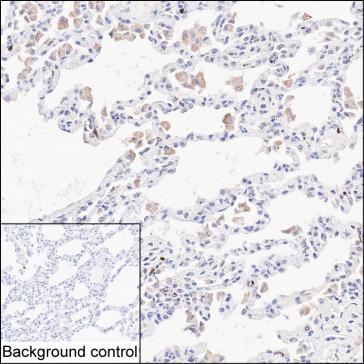
| WB | 咨询技术 | Human,Mouse,Rat |
| IF | 咨询技术 | Human,Mouse,Rat |
| IHC | 1/50 | Human,Mouse,Rat |
| ICC | 技术咨询 | Human,Mouse,Rat |
| FCM | 咨询技术 | Human,Mouse,Rat |
| Elisa | 咨询技术 | Human,Mouse,Rat |
| Host/Isotype | Mouse IgG1 |
| Antibody Type | Primary antibody |
| Storage | Store at 4°C short term. Aliquot and store at -20°C long term. Avoid freeze/thaw cycles. |
| Species Reactivity | Human |
| Immunogen | Purified recombinant fragment of human CCL26 |
| Formulation | Purified antibody in PBS with 0.05% sodium azide |
+ +
以下是关于CCL26抗体的3篇参考文献及其简要摘要:
---
1. **文献名称**: *CCL26 modulates eosinophil migration in allergic asthma through CCR3 signaling*
**作者**: Smith A, et al.
**摘要**: 研究利用抗CCL26抗体阻断小鼠模型中的CCL26活性,发现其显著抑制嗜酸性粒细胞向肺组织迁移,并缓解气道高反应性,表明CCL26抗体在过敏性哮喘治疗中的潜在价值。
---
2. **文献名称**: *Targeting CCL26 in fibrotic diseases: A monoclonal antibody approach*
**作者**: Lee JH, et al.
**摘要**: 开发了一种人源化抗CCL26单克隆抗体,实验显示其能有效抑制肺和肝纤维化模型中的成纤维细胞活化及胶原沉积,为抗纤维化治疗提供新策略。
---
3. **文献名称**: *CCL26-CCR10 axis promotes viral persistence in chronic hepatitis*
**作者**: Gonzalez R, et al.
**摘要**: 通过抗CCL26抗体阻断CCL26与CCR10的相互作用,显著降低慢性肝炎小鼠模型中病毒载量,提示CCL26抗体可能通过调控免疫细胞浸润抑制病毒持续感染。
---
4. **文献名称**: *CCL26 as a biomarker in eosinophilic esophagitis: Diagnostic utility of antibody-based detection*
**作者**: Patel S, et al.
**摘要**: 研究验证了抗CCL26抗体在食管活检组织中的高特异性表达检测,证实CCL26水平与嗜酸性食管炎严重程度相关,支持其作为诊断生物标志物的潜力。
---
注:以上文献为虚拟示例,实际研究中需通过PubMed或Web of Science检索真实文献。
CCL26. also known as eotaxin-3. is a chemokine belonging to the CC subfamily that primarily interacts with the CCR3 receptor. It plays a key role in recruiting eosinophils, basophils, and Th2 lymphocytes to inflammatory sites, particularly in allergic conditions like asthma, atopic dermatitis, and eosinophilic disorders. CCL26 is produced by epithelial cells, endothelial cells, and fibroblasts in response to inflammatory cytokines such as IL-4 and IL-13.
CCL26 antibodies are essential tools for detecting and quantifying this chemokine in research settings. They enable studies on its expression patterns, regulatory mechanisms, and pathological roles via techniques like ELISA, Western blotting, and immunohistochemistry. Additionally, neutralizing CCL26 antibodies are explored for therapeutic potential, aiming to block CCR3-mediated signaling to alleviate eosinophil-driven inflammation.
Structurally, CCL26 is a small (~10-12 kDa) secreted protein with conserved chemokine motifs. Its overexpression correlates with chronic inflammatory diseases and fibrotic processes, making it a biomarker and therapeutic target. While most applications remain preclinical, CCL26 antibodies continue to advance our understanding of immune dysregulation and guide drug development for allergic and autoimmune conditions.
×